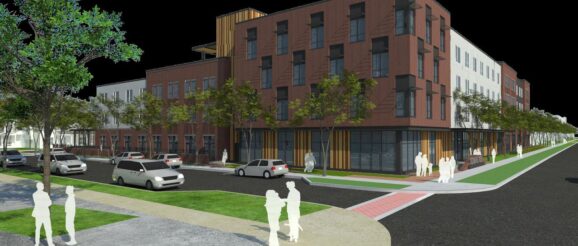Cleveland planning commission to review proposed apartment building set for ‘Innovation Square’ in Fairfax neighborhood – cleveland.com

CLEVELAND, Ohio — The Cleveland City Planning Commission on Friday will consider the first phase of a large project designed to add hundreds of homes and a grocery store to the city’s Fairfax neighborhood near the Cleveland Clinic’s main campus.
The commission could grant approval to designs for an 80,000-square-foot apartment building at Hudson Avenue and East 105th Street along the Opportunity Corridor, a long-awaited new boulevard linking Interstate 77 to University Circle. The four-story building, when completed, will be the first 82 apartments added to “Innovation Square,” which will be bordered by East 97th and East 105th streets and Cedar and Quebec avenues.
“Our goal is to build community, and part of that is new housing opportunities, new employment opportunities, new opportunities to shop and walk to amenities,” Fairfax Renaissance Development Corporation Denise VanLeer said. The nonprofit has led efforts over the years to plan Innovation Square and ensure it comes to fruition.
While houses within the area are under construction by Knez Homes, with some already pre-sold, the apartment building will be the first one within Innovation Square, VanLeer said. Other buildings, such as a biorepository for the Clinic run by the Massachusetts-based Brooks Life Sciences at Cedar Avenue and East 100th Street, are nearly complete.
The development corporation partnered with McCormack Baron Salazar of St. Louis for the Innovation Square apartment project. Designs made it past a design review committee last week, and the planning commission will decide whether to give its blessing. If it does, the commission would still need to give final approval at a later date.
Alex Pesta of City Architecture, which designed the building and worked with the development corporation, said developers hope the design makes a positive first impression of the neighborhood. Inside, it will feature a mix of efficiency, one and two-bedroom units for residents at mixed incomes. The ground floor will feature communal spaces, and the building will also have a rooftop deck and other amenities to encourage residents to get outside as much as possible.
Parking will be limited, though developers expect people who live there will take advantage of public transportation.
VanLeer said she expects workers to break ground on the new apartment building by summer and finish sometime next year. Work on the building, as well as planning the development, has chugged along for years, though VanLeer said they encountered some delays because of the practical effects of the coronavirus pandemic.
But work has continued. Work on a park planned as part of the design finished. Earlier this month, Cleveland City Council passed a measure to change the zoning for the area to allow for the development corporation’s plans to move forward.
In addition to the new apartment buildings and houses under construction, the plan involves a grocery store at Cedar Avenue and East 105th Street. Clinic officials previously acknowledged that it has spoken to executives at the western Michigan-based grocery store chain.
Councilman Blaine Griffin has said the addition of a grocery store would be significant, as there isn’t one nearby for the residents.
While the overall goal is to add 500 homes, VanLeer said it’s also to connect the surrounding Fairfax residents to new opportunities in the health technology field.
That includes new jobs created as part of a new nearby “innovation district,” a separate project recently announced by Ohio. The state and its economic development group committed $265 million in cash and tax incentives to the project designed to have the three Cleveland hospital systems, Case Western Reserve University and Cleveland State University, to research infectious diseases. In an announcement earlier this month, the state touted a goal of creating 20,000 jobs in the Cleveland area over the next decade.
The Clinic, as part of what the state calls an “innovation district,” plans to build the Global Center for Pathogen Research & Human Health on its campus. VanLeer said planning for Innovation Square began in 1995, and even later, it was clear the new houses would be there for more extensive projects involving Cleveland’s health technology industry.
“This is not a surprise to us because you could see the handwriting on the wall 10-15 years ago,” VanLeer said. “It’s a realization of what we were thinking about many years ago.”
